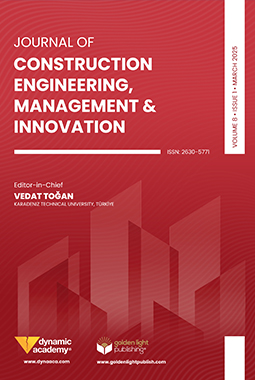ISSN:2630-5771
Journal of Construction Engineering, Management & Innovation
ARTICLES
Faruk Ergen
Önder Halis Bettemir
Building Information Modeling (BIM) prepares quantity take-off of construction items, helps the management of the design and construction process and prepares 3D visualization of the construction phases. BIM offers more control on the construction tasks and improves the efficiency. Construction professional are aware of the benefits of the BIM however, the utilization of BIM is still not common yet because of the BIM software cost and training requirement of the staff. In this study, open source BIM software is developed by Python programming language. The software is capable of preparation of 2 dimensional drawings, 3D visualization as well as execution of quantity take-off computations of formwork and concrete. The codes are developed on Python language by using SQlite library and Ursina engine. Graphical user interface is formed by Python language for the execution of 2 Dimensional drawings and entries of the coordinates of the structural elements as well as attribute data. 3D coordinates of the structural elements are computed by using the joint coordinates of the structural elements. 3D visualizations of the structural elements are performed by the Ursina engine. The connections and intersections of the joints and structural elements are stored in database which is formed by SQlite. The voids are successfully computed and formwork and concrete quantities are computed. The open source BIM software would have low investment and operational costs for the construction firms and would increase the BIM usage. The utilization of the software would decrease the manmade errors during the quantity take-off preparation step.
https://doi.org/10.31462/jcemi.2022.01001014
Kemal Dirgen Tozer
Gürkan Emre Gürcanlı
Zalihe Yalkıner
The study aims to build a model for workday losses due to scaffolding accidents at
construction sites to know information about the worker and the accident, and
subsequently use the model for prediction, process optimization, or process control. The
accident investigations from the archive of the Labour Office were searched and ongoing
construction sites in North Cyprus were visited. Descriptive statistics were used to classify
the full archival and inferential statistics were carried out to construct a statistical model
using multiple linear regression (MLR) analysis to predict future workday losses
furthermore binary logistic regression (BLR) model was carried out to identify whether
the workday loss is considered to be a major workday loss or not. MLR model revealed
that a 4.5-fold increase in workdays lost for each additional 1 meter of fall height and
one year increase in workers’ age will increase the workday losses by 1.3 days.
Additionally, the BLR model concluded that when the age of the victim increased by one
unit, victims are 1.068 times more likely to have a major workday loss, and similarly,
when the height of falling increases by one unit, victims are 1.735 more likely to have a
major workday loss.
https://doi.org/10.31462/jcemi.2022.01015027
Mahshad Azima
Senem SEYİS
Buildings require a significant amount of energy for heating, cooling, and lighting. Hence, building energy performance has become one of the most important topics in the architecture, engineering, and construction (AEC) industry in the recent decade. The building envelope plays a critical role in maximizing energy efficiency and decreasing energy consumption generally. The research objective of this study is to examine and compare the effects of three different building envelope types on energy performance in a high-rise residential building. Literature review and case study were performed for achieving the research objective of this study. In the literature review, records (i.e., journal articles, conference proceedings, and scientific reports) published between 2011 and 2021 were included, and Web of Science and Scopus databases were used. In the case study, passive methods including building design, orientation, insulation, window-wall ratio, and shelter were employed for a 10-story reinforced concrete residential building in Istanbul, Turkey. The energy performance of the different wall, insulation, and glass components utilized in the building was analyzed and compared using DesignBuilder software. Findings show that each parameter and material have a significant impact on the energy performance of a structure. This research would make a noteworthy contribution to the AEC literature and industry by analyzing the energy performance of different building envelope types and the appropriate scenarios based on the location. Results of this study can be used by policymakers and decision-makers to revise existing codes and policies for new high-rise buildings.
https://doi.org/10.31462/jcemi.2022.01028044
Mahsa Moloodpoor
Ali Mortazavi
The total heating cost of residential buildings corresponds to a significant part of the energy consumption of countries. Designing cost-efficient residential buildings in terms of energy gains importance. In the current study, it is targeted to take a beneficial step that will contribute to this issue. In this respect, the decisive components for the calculation of the total heating cost of insulated buildings (i.e. the fuel type, insulation material, and insulation thickness) are determined optimally. For this aim, an optimization model is utilized in which the total heating cost based on life cycle cost analysis is considered as the objective function. The design variables are selected from both continuous and discrete spaces and they are dependent on each other. For solving the problem with such a complex search domain, different well-established non-gradient and population-based optimization techniques are utilized. These methods do not require the information of the objective functions so they can be used widely in solving different optimization problems. In addition, multivariable thermo-economic optimization for minimizing the total heating cost of the insulated building with the selected methods presents the effect and power of the population-based methods in solving different engineering optimization problems. The considered methods are tested on unconstrained mathematical functions and thermo-economic optimization of five distinct locations from the Aegean region of Turkey. The comparative assessments are reported and discussed in detail. Different analyses are employed for evaluating the performance of the optimization techniques. According to the archived outcomes, the utilized optimization techniques present acceptable performance in handling both discrete and continuous design variables.
https://doi.org/10.31462/jcemi.2022.01045063


